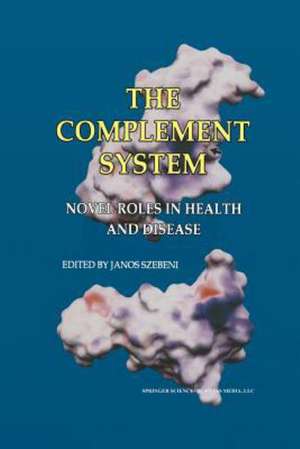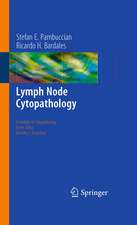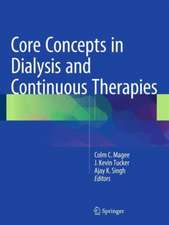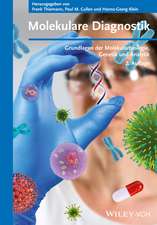The Complement System: Novel Roles in Health and Disease
Editat de Janos Szebenien Limba Engleză Paperback – 22 mar 2013
| Toate formatele și edițiile | Preț | Express |
|---|---|---|
| Paperback (1) | 1425.76 lei 6-8 săpt. | |
| Springer Us – 22 mar 2013 | 1425.76 lei 6-8 săpt. | |
| Hardback (1) | 1433.46 lei 6-8 săpt. | |
| Springer Us – 9 iun 2004 | 1433.46 lei 6-8 săpt. |
Preț: 1425.76 lei
Preț vechi: 1500.81 lei
-5% Nou
Puncte Express: 2139
Preț estimativ în valută:
272.81€ • 284.84$ • 225.79£
272.81€ • 284.84$ • 225.79£
Carte tipărită la comandă
Livrare economică 04-18 aprilie
Preluare comenzi: 021 569.72.76
Specificații
ISBN-13: 9781475779288
ISBN-10: 1475779283
Pagini: 592
Ilustrații: XXI, 565 p.
Dimensiuni: 155 x 235 x 35 mm
Greutate: 0.82 kg
Ediția:Softcover reprint of the original 1st ed. 2004
Editura: Springer Us
Colecția Springer
Locul publicării:New York, NY, United States
ISBN-10: 1475779283
Pagini: 592
Ilustrații: XXI, 565 p.
Dimensiuni: 155 x 235 x 35 mm
Greutate: 0.82 kg
Ediția:Softcover reprint of the original 1st ed. 2004
Editura: Springer Us
Colecția Springer
Locul publicării:New York, NY, United States
Public țintă
ResearchDescriere
As a phylogenetically old system complement is now regarded as a part of innate immunity. But it is much more than that. It bridges innate and adapted immunity, participates not only in host defense but also in many essential physiological processes, old and new diseases and adverse conditions. Indeed, complement became a term that almost defies categorization. What was for a long time a subject for a limited number of specialists has now moved into the mainstream of experimental and clinical immunology. In 1973 I visited the Basel Institute of Immunology and met its director, the eminent scientist and Nobel laureate Nils Jerne. When I entered his office he greeted me with the following words: “Complement, does that really exist?” I was never certain whether he wanted only to tease me or whether he sincerely believed that the complement system was an unimportant biological curiosity, a misstep of evolution. But, of course, missteps do not survive the evolutionary process. Little did I foresee the dramatic developments of recent years when Hans J. Müller-Eberhard and I started to unravel the specifics of the action of the cobra venom factor on the complement system in 1968 and defined a new pathway to its activation. An elucidation of the role of the system in diseases and its control for therapeutic reasons is now getting closer to actual realization in the clinic although many problems, in particular those of highly specificinhibition free of side effects, have still to be resolved.
Cuprins
Dedication. Contents. List of Contributors. Foreword by Otto Götze. Preface; J. Szebeni. The Complement System: Novel Roles in Health and Disease. Part 1: A Piece of Complement History. The Development of the 'One-Hit' or 'Single Site' Theory of Complement Mediated Immune Hemolysis. A personal account; T. Borsos. Part 2: Pathways, Genetics and Gene Regulation of Complement. The initiation complexes of the classical and lectin pathways; P. Gál, G. Ambrus, Zs. Lorincz, P. Závodszky . Complement genetics; Gy. Ábel, V. Agnello. Regulation of complement receptor gene expression: Regulators and inhibitors; M. Tolnay, G.C. Tsokos. Part 3: Novel Regulatory Roles of Complement in Health and Disease. Coordination of adaptive immune responses by C3; A. Erdei, E. Molnár, E. Csomor, Zs. Bajtay, J. Prechl. Terminal complement complex: regulation of formation and pathophysiological functions; F. Tedesco, R. Bulla, F. Fischetti. The many faces of the membrane regulators of complement; C.L. Harris, B.P. Morgan . New insights in the function of decay accelerating factor; L. Kuttner-Kondo, M.E. Medof. The role of complement in pregnancy and fetal loss; G. Girardi, J.E. Salmon. Complement deficiencies: a 2004 update; Gy. Ábel, V. Agnello. Part 4: Exploitation of Complement Proteins in Infection and Cancer. Microbial evasion mechanisms against human complement ; R. Würzner P.F. Zipfel. Complement-mediated antibody-dependent enhancement of viral infections; Z. Prohászka, F.D. Tóth, D. Bánhegyi, G. Füst. Tumor cell resistance to complement-mediated lysis; M. Kirschfink, Z. Fishelson. Part 5: Role of complement in AutoimmuneDiseases, Allergy and Transplantation. Complement and autoimmunity; G.C. Tsokos, M. Tolnay. The complex roles of anaphylatoxins in allergic asthma and autoimmune diseases; H. Hawlisch, M. Wills-Karp, C.L. Karp, J. Köhl. Role of complement in allergy; L. Varga, H. Farkas, G. Füst. Complement activation-related pseudoallergy: Mechanism of anaphylactoid reactions to drug carriers and radiocontrast agents; J. Szebeni. The Role of Complement in Transplantation; M. Kirschfink, T.E. Mollnes. Part 6: Role of Complement in Severe Acute Illnesses. Role of complement in myocardial ischemia and infarction; M.C. Walsh, M.L. Hart, T.M. Bourcier, D. Bhole, M. Takahashi, G.L. Stahl. Role of complement in intestinal ischemia/reperfusion induced injury; S.D. Fleming, G. Tsokos. Role of C5a and C5a receptor in sepsis; F.S. Zetoune, P.A. Ward, M.S. Huber-Lang. Role of complement in multi-organ dysfunction syndrome; M.S. Huber-Lang, J.V. Sarma, F.S. Zetoune, P.A. Ward. Part 7: The Complement System as Therapeutical Target. Therapeutic manipulation of the complement system; T.E. Mollnes. Activation and inhibition of complement by immunoglobulins; M. Basta. Engineering control of complement inhibition at the cell surface; R.A.G. Smith, D. Esser, S.H. Ridley, R. Bradford. Index.









